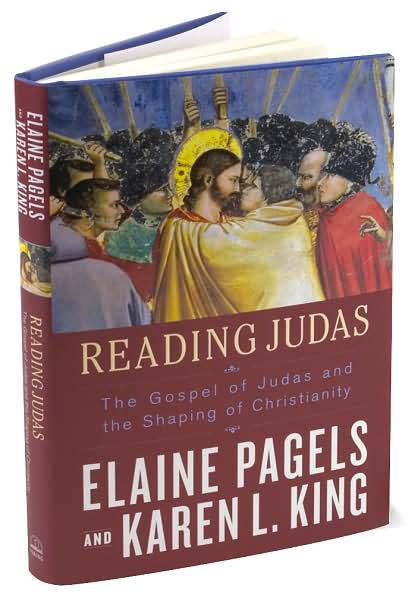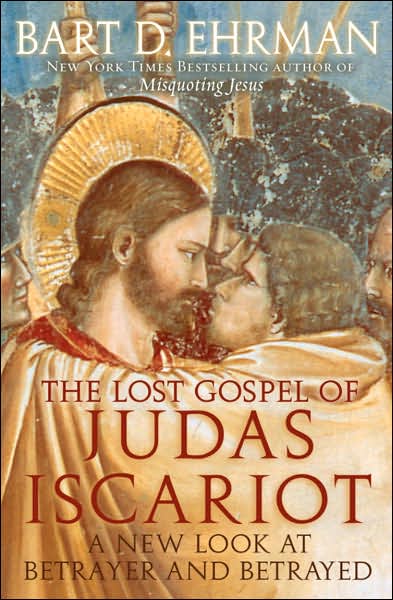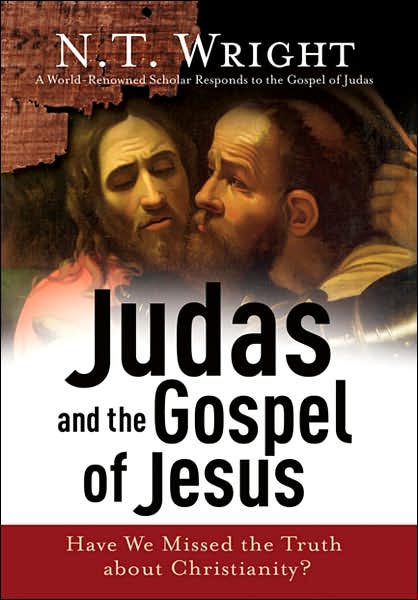 The Gospel of Judas, along with other Gnostic texts, is important in understanding Christianity's genesis. It challenges some of the depictions of the canonical Gospels. When it was published by the National Geographic Society in April 2006, it received extraordinary media attention and was immediately heralded as a major biblical discovery that excited the world of scholars and laypeople alike.
The Gospel of Judas, along with other Gnostic texts, is important in understanding Christianity's genesis. It challenges some of the depictions of the canonical Gospels. When it was published by the National Geographic Society in April 2006, it received extraordinary media attention and was immediately heralded as a major biblical discovery that excited the world of scholars and laypeople alike.In Reading Judas Elaine Pagels and Karen King describe its ramifications for telling the story of early Christianity. They illustrate how the document provides a window into understanding how Jesus' followers understood his death, why Judas betrayed Jesus, and why God allowed it. (Short video discussing the Gospel of Judas) Their book illuminates the intellectual assumptions behind Jesus' teaching to Judas and shows how conflict among the disciples was a tool frequently used by early Christian authors to explore matters of doubt and disagreement. (Audio interview with Pagels and King hosted by NPR's Terry Gross)
In The Lost Gospel of Judas Iscariot: A New Look at Betrayer and Betrayed, Bart
 Ehrman, provides an overview of Judas in the traditional New Testament, but he also surveys the Gospel of Judas, from its discovery to its content. "Throughout the Christian tradition," writes Ehrman, "Judas has been portrayed as the rotten apple in the apostolic barrel." Yet the Gospel of Judas reveals a radical new understanding of Christ's mission and Judas's role in it. Judas, in fact, is the lone member of Christ's inner circle who understood Jesus's message. Furthermore, Judas did not really betray Christ. According to Ehrman, his action was a "kind deed performed for the sake of his Lord."
Ehrman, provides an overview of Judas in the traditional New Testament, but he also surveys the Gospel of Judas, from its discovery to its content. "Throughout the Christian tradition," writes Ehrman, "Judas has been portrayed as the rotten apple in the apostolic barrel." Yet the Gospel of Judas reveals a radical new understanding of Christ's mission and Judas's role in it. Judas, in fact, is the lone member of Christ's inner circle who understood Jesus's message. Furthermore, Judas did not really betray Christ. According to Ehrman, his action was a "kind deed performed for the sake of his Lord."Ehrman, a featured commentator in the National Geographic special, describes how he first saw the Gospel of Judas--surprisingly, in a small room above a pizza parlor in a Swiss town near Lake Geneva--and how it came to be restored and translated. Ehrman gives the reader an account of what the book teaches and shows how it relates to other Gospel texts--both those inside the New Testament and those outside of it, most notably, the Gnostic texts of early Christianity. Finally, he describes what we now can say about the historical Judas himself as well as his relationship with Jesus, suggesting that one needs to read between the lines of the early Gospels to see exactly what Judas did and why he did it.
 Biblical scholar N. T. Wright (bishop of Durham, Church of England) says that the Gospel of Judas contradicts his view that Judas did betray Jesus and was not his compatriot, as this noncanonical Gospel maintains. In Judas and the Gospel of Jesus Wright disputes that the Gospel of Judas reveals any new truth about Christianity. He recognizes that the Gospel of Judas is a Gnostic text and characterizes Gnosticism as opposed to the created world, open to secret wisdom, and in denial about the Resurrection of Jesus.
Biblical scholar N. T. Wright (bishop of Durham, Church of England) says that the Gospel of Judas contradicts his view that Judas did betray Jesus and was not his compatriot, as this noncanonical Gospel maintains. In Judas and the Gospel of Jesus Wright disputes that the Gospel of Judas reveals any new truth about Christianity. He recognizes that the Gospel of Judas is a Gnostic text and characterizes Gnosticism as opposed to the created world, open to secret wisdom, and in denial about the Resurrection of Jesus.However, a review by Library Journal points out that a quick look at the canonical Gospel of Mark will reveal that the disciples were told to keep messianic secrets and that they should deny this world and Mark ends with no mention of the Resurrection. Wright is very critical of Pagels, King, and Ehrmann in spite of their expertise in analyzing Gnostic texts.
Is the Judas Gospel a spectacular archaeological find having little relevance to Christian theology?
Posted April 30, 2007
 In an interesting series of articles,
In an interesting series of articles,  Recently the media in the United States has fixated on racial and misogynistic comments made by Don Imus about a group of minority women (
Recently the media in the United States has fixated on racial and misogynistic comments made by Don Imus about a group of minority women ( brothers/sisters to have a near monopoly on 'born again' language. There are a number of reasons for this. For some, the language may be too hot and heavy because of its associations with 'revivals' and a 'sweaty' kind of Christianity.
brothers/sisters to have a near monopoly on 'born again' language. There are a number of reasons for this. For some, the language may be too hot and heavy because of its associations with 'revivals' and a 'sweaty' kind of Christianity.  ABC News reported: Imus made the now infamous remark during his show last Wednesday. The Rutgers team, which includes eight black women, had lost the day before in the NCAA women's championship game. Imus was speaking with producer Bernard McGuirk about the game when the exchange began on "Imus in the Morning." The show is broadcast on more than 70 stations and MSNBC.
ABC News reported: Imus made the now infamous remark during his show last Wednesday. The Rutgers team, which includes eight black women, had lost the day before in the NCAA women's championship game. Imus was speaking with producer Bernard McGuirk about the game when the exchange began on "Imus in the Morning." The show is broadcast on more than 70 stations and MSNBC. A Grief Observed was first published in 1961 and concerns the death of C. S. Lewis's wife, the American-born poet Joy Davidman (whom he refers to as 'H') after just three years of marriage. It probes the "mad midnight moments" of Lewis's mourning and loss, moments in which he questioned what he had previously believed about life and death, marriage, and even God. Indecision and self-pity assailed Lewis. "We are under the harrow and can't escape," he writes. "I know that the thing I want is exactly the thing I can never get. The old life, the jokes, the drinks, the arguments, the lovemaking, the tiny, heartbreaking commonplace." Writing A Grief Observed as "a defense against total collapse, a safety valve," he came to recognize that "bereavement is a universal and integral part of our experience of love."
A Grief Observed was first published in 1961 and concerns the death of C. S. Lewis's wife, the American-born poet Joy Davidman (whom he refers to as 'H') after just three years of marriage. It probes the "mad midnight moments" of Lewis's mourning and loss, moments in which he questioned what he had previously believed about life and death, marriage, and even God. Indecision and self-pity assailed Lewis. "We are under the harrow and can't escape," he writes. "I know that the thing I want is exactly the thing I can never get. The old life, the jokes, the drinks, the arguments, the lovemaking, the tiny, heartbreaking commonplace." Writing A Grief Observed as "a defense against total collapse, a safety valve," he came to recognize that "bereavement is a universal and integral part of our experience of love." sadness. Labeled "nontraditional grief response" by therapists and counselors, a positive reaction following a death is becoming more common, especially now that drugs and medical treatments keep people alive much longer than they or their families might wish. Sometimes we are relieved that our loved one is no longer suffering; at the other end of the spectrum, a death might finally free us of an abusive or unhappy relationship. In either case, the cultural expectation for sadness, loneliness, and despair only adds to the guilt and conflict felt by many "relieved grievers."
sadness. Labeled "nontraditional grief response" by therapists and counselors, a positive reaction following a death is becoming more common, especially now that drugs and medical treatments keep people alive much longer than they or their families might wish. Sometimes we are relieved that our loved one is no longer suffering; at the other end of the spectrum, a death might finally free us of an abusive or unhappy relationship. In either case, the cultural expectation for sadness, loneliness, and despair only adds to the guilt and conflict felt by many "relieved grievers." In an article in the NY times on April 2, 2007 Jane Perlez wrote in part: Clitheroe, England — This town opted to allow a former Christian church to become a mosque. The vote marked the end of a bitter struggle by the Muslim population to establish a place of worship, one that will put a mosque in a Methodist church. The battle underscored Britain’s unease with its Muslim minority, and particularly the infiltration of terrorist cells among the faithful, whose devotion has challenged an increasingly secular Britain’s sense of itself. Britain may continue to regard itself as a Christian nation but practicing Muslims are likely to outnumber church-attending Christians in several decades. With a population of 14,500 people in Clitheroe liked to think they represented a last barrier to the mosques that had become features in surrounding industrial towns. But Clitheroe had not bargained on the determination of Mr. Arshad - the British-born son of Mohamed Arshad, who came to Clitheroe from Rawalpindi in 1965.
In an article in the NY times on April 2, 2007 Jane Perlez wrote in part: Clitheroe, England — This town opted to allow a former Christian church to become a mosque. The vote marked the end of a bitter struggle by the Muslim population to establish a place of worship, one that will put a mosque in a Methodist church. The battle underscored Britain’s unease with its Muslim minority, and particularly the infiltration of terrorist cells among the faithful, whose devotion has challenged an increasingly secular Britain’s sense of itself. Britain may continue to regard itself as a Christian nation but practicing Muslims are likely to outnumber church-attending Christians in several decades. With a population of 14,500 people in Clitheroe liked to think they represented a last barrier to the mosques that had become features in surrounding industrial towns. But Clitheroe had not bargained on the determination of Mr. Arshad - the British-born son of Mohamed Arshad, who came to Clitheroe from Rawalpindi in 1965.